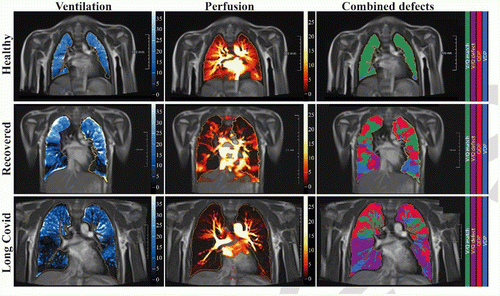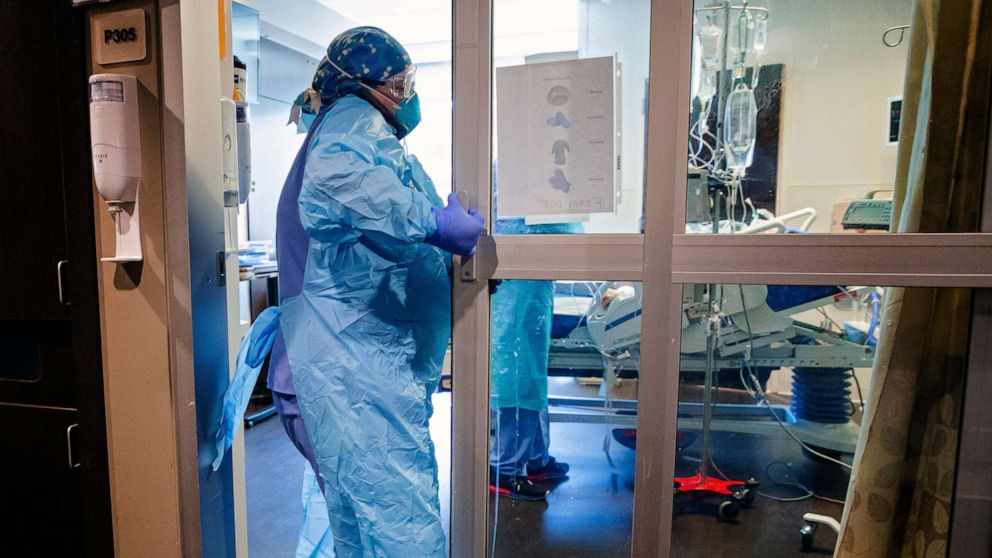You are using an out of date browser. It may not display this or other websites correctly.
You should upgrade or use an alternative browser.
You should upgrade or use an alternative browser.
COVID-19 Pandemic (Coronavirus)
- Thread starter null
- Start date
More options
Who Replied?
Lasting Lung Damage Seen in Children and Teens after COVID
September 20, 2022 — Children and adolescents who have either recovered from COVID-19 or have long COVID show persistent lung damage on MRI, according to a
SEPTEMBER 20, 2022
Lasting Lung Damage Seen in Children and Teens after COVID

September 20, 2022 — Children and adolescents who have either recovered from COVID-19 or have long COVID show persistent lung damage on MRI, according to a study published in Radiology, a journal of the Radiological Society of North America (RSNA).Free-breathing phase-resolved functional lung (PREFUL) low-field MRI at 0.55T with calculated parameters at an axial plane after automatic registration to a mid-expiration position and lung parenchyma segmentation. From left to right, representative color-coded images of functional show ventilation defects (VDP, blue), perfusion defects (QDP, red), ventilation/perfusion (V/Q match, green), ventilation/perfusion defects (V/Q defect, purple) in a healthy control (upper row, 7-year-old male), a participant recovered from COVID-19 (middle row, 10-year-old male) and a participant with long COVID (15-year-old male). Image courtesy of Radiology
COVID-19 is an infectious disease caused by the SARS-CoV-2 virus. Since emerging in late 2019, it has killed more than 5 million people worldwide. The lungs are the primary target for the virus.
Study of the disease’s long-term effects has accelerated as the number of COVID survivors climbs and more people are diagnosed with long COVID. The World Health Organization defines long COVID as involving symptoms that persist for a minimum of 12 weeks and other factors, such as symptoms that result in a new health limitation or worsening of a pre-existing underlying medical condition.
The nature of the post-acute phase of the infection is poorly understood in younger people. CT has shown persistent damage to the lungs in adults, but CT uses ionizing radiation and has limited diagnostic value in children, where lung changes due to COVID-19 are less pronounced.
“We conceived this study when the evidence for long- or post-COVID cases in adults was growing,” said study senior author Ferdinand Knieling, M.D., specialist in pediatrics and adolescent medicine from the departments of Pediatrics and Adolescent Medicine at University Hospital Erlangen in Erlangen, Germany. “This was also when the first patients with unspecific symptoms were seen in our department, and parents started to ask about an association with a prior infection.”
Dr. Knieling and colleagues studied COVID-19’s effects in children and adolescents using low-field MRI. The technology relies on a lower magnetic field than conventional MRI and allows for free breathing, meaning the subjects do not have to hold their breath during imaging. This makes scanning more feasible in children.
“As parents, we also wanted to find what risks an infection might have,” Dr. Knieling said. “Luckily, our departments teamed up to use their brand-new MRI scanner designed for investigations in children and adolescents.”
The researchers looked at changes in lung structure and function in 54 children and adolescents (mean age 11 years) with previous SARS-CoV-2 infection. Of the 54 patients, 29 had recovered, and 25 had long COVID. All but one of the patients had been unvaccinated at the time of original infection.
None of the COVID-19 group required hospital admission during the primary infection period. Shortness of breath, impaired attention, headache, fatigue and loss of smell were the most commonly reported symptoms at the time of the study. Results from the COVID-19 group were compared with those from nine healthy controls.
MRI allowed the researchers to derive the V/Q match, a measure of air and blood flow in the lungs. If lungs are working properly, the air and blood flow should match.
V/Q matches showed persistent pulmonary dysfunction in the patients who had recovered from COVID-19 and in those with long COVID. The V/Q match was 62% in the recovered group and 60% in the long COVID group—both considerably lower than the 81% match in healthy controls.
“Persistent symptoms after COVID still cause diagnostic odysseys, and this is especially true for young people,” Dr. Knieling said. “Our findings illustrate that caring for these patients is a multidisciplinary challenge.”
Long-term implications of these lung changes remain unclear, but the results warrant further surveillance of persistent lung damage in children and adolescents after COVID-19, Dr. Knieling said. Lung MRI is already widely available, he noted, making these imaging approaches easy to integrate into clinical routine care. More research will help show the full potential of MRI in COVID-19 survivors.
“A follow-up trial has already started, and we seek to understand how findings change over time,” Dr. Knieling said. “Additionally, we will take closer looks at other organs to see how this correlates with our findings.”
For more information: www.rsna.org

Covid will be a leading cause of death in the U.S. indefinitely, whether or not the pandemic is 'over'
https://www.nbcnews.com/health/health-news/covid-will-leading-cause-death-indefinitely-us-rcna48374 Disease experts predict that Covid will remain among the top 10 causes of death in the U.S. for the foreseeable future. Shannon Pettypiece Shannon Pettypiece is the senior White House reporter...
 www.thecoli.com
www.thecoli.com
@bnew when are you getting the bivalent booster shot? I am getting mine in November.
I'll probably get mines in november if not sooner.

Nearly 225,000 Americans have died of COVID-19 since the start of 2022 despite viral declines, data shows
Although the daily death rates have ticked down slightly from August, the U.S. is still losing hundreds of Americans to the virus every day.
Women said coronavirus shots affect periods. New study shows they’re right.
A coronavirus vaccination can change the timing of when you get your period, according to research. For most people, the effect was temporary.
By Amanda Morris
September 27, 2022 at 11:00 a.m. EDT
Not long after the rollout of coronavirus vaccines last year, women around the country began posting on social media about what they believed was a strange side effect: changes to their periods.
Now, new research shows that many of the complaints were valid. A study of nearly 20,000 people around the world shows that getting vaccinated against covid can change the timing of the menstrual cycle. Vaccinated people experienced, on average, about a one-day delay in getting their periods, compared with those who hadn’t been vaccinated.
The data for the study, published Tuesday in the British Medical Journal, was taken from a popular period-tracking app called Natural Cycles and included people from around the world, but most were from North America, Britain and Europe. The researchers used “de-identified” data from the app to compare menstrual cycles among 14,936 participants who were vaccinated and 4,686 who were not.
Because app users tracked their menstrual cycles each month, the researchers were able to analyze three menstrual cycles before vaccination and at least one cycle after, and compare them with four menstrual cycles in the unvaccinated group.
The data showed that vaccinated people got their periods 0.71 days late, on average, after the first dose of vaccine. However, people who received two vaccinations within one menstrual cycle experienced greater disruptions. In this group, the average increase in cycle length was four days, and 13 percent experienced a delay of eight days or more, compared with 5 percent in the control group.
Alison Edelman, a professor of obstetrics and gynecology at Oregon Health & Science University, who led the study, said that for most people the effects were temporary, lasting for one cycle before returning to normal. She said there were no indications that the period side effects had any impact on fertility.
“Now we can give people information about possibly what to expect with menstrual cycles,” Edelman said. “So I hope that’s overall really reassuring to individuals.”
Researchers don’t know exactly why the vaccines seem to affect menstrual cycles, but Edelman said that the immune and reproductive systems are linked and that inflammation or a strong immune response could trigger menstrual fluctuation.
Any change in getting your period can be stressful, triggering worries about an unplanned pregnancy or an illness, and people have expressed frustration that public health officials didn’t warn them about the possible side effect or do more research before rolling out the vaccines.
One major limitation of the study is the fact that it included only those who were not on birth control, had regular cycles before getting vaccinated and were between the ages of 18 and 45.
The study also didn’t answer all of the questions raised by people about vaccines and periods, including how the shots affect trans men and nonbinary individuals. Ever since the vaccines were rolled out, many people on social media have complained of longer, heavier and more-painful periods after getting vaccinated. This study did not look at the heaviness of periods or other side effects such as cramps, but researchers said it did show that, on average, getting vaccinated did not appear to cause longer periods.
Edelman said preliminary findings from a different study suggest that getting a coronavirus vaccine sometimes may cause heavier periods. The data, collected from nearly 10,000 people, is still undergoing peer review, but it showed that getting vaccinated increased slightly the probability of having heavier bleeding.
However, she acknowledged that her studies have looked only at people with normal menstrual cycles who aren’t using hormonal contraceptives, and that individual experiences may vary widely.
Caiityya Pillai, 21, who lives in Berkeley, Calif., said that for two months after her March 2021 shot, her normally light period became extremely painful and lasted twice as long.
“The pain wasn’t like a normal pain. It was to the point where I was crying and could not get out of bed,” she said.
Pillai said that she was overwhelmed with anxiety and thought something else might be wrong, but that after two cycles, her period returned to normal. When she got a second dose in July 2021, her period worsened again, but she said she felt calmer about it because she had seen similar stories being shared online.
Other research has suggested that the vaccines have a variety of effects on periods. A survey published last fall collected information about periods and vaccines from 160,000 people — including transgender and postmenopausal people — and found that thousands reported heavier bleeding than usual or breakthrough bleeding.
While these observations aren’t necessarily medically alarming, Katharine Lee, an assistant professor at Tulane University who led the survey, said the information is important to help trans men plan for additional support if menstruating causes gender dysphoria, and also to help people make decisions about stocking up on tampons and pads.
Lorena Grundy, 27, uses an IUD and hadn’t had her period for over three years before she got her first Pfizer shot in February 2021. The next day at work, she got her period.
“It wasn’t that the vaccine moved my period early or late — it produced one,” said Grundy, who lives in Somerville, Mass.
If she had been made aware of the side effect, she said, she would have prepared and brought a pad to work. Her period lasted three or four days — and it came back when she got her second vaccine dose three weeks later. But it didn’t happen again when she got a booster shot last November.
“I think it’s good to validate that we should listen to women about their own bodies,” she said. “I’m still glad I got vaccinated, but I do think maybe this shows that it’s a symptom we should be preparing people for so they’re not alarmed by it.”
Although Edelman’s research suggested that period changes are temporary, some people have reported lasting shifts in menstrual cycles long after getting a shot.
Sammi Beechan, 32, of Hammond, Ore., said they used to have a “blessed, beautiful cycle” that came every 28 days “like clockwork” and resulted in mild cramps and only four days of light to medium bleeding.
After a Johnson & Johnson shot in April 2021, nothing changed, but after getting a Moderna booster that October, Beechan noticed that their period started to come every 24 days with more than four days of heavier bleeding, more-painful cramps and extreme mood shifts. Doctors have ruled out endometriosis and other potential health conditions as the cause.
Beechan said that getting vaccinated against covid is worth it but that they wish more information about period side effects had been provided ahead of the vaccine rollout. “I went from having very consistent expectations and now each month I’m like, okay, I guess this is what it is,” Beechan said.
Diana Bianchi, the director of the Eunice Kennedy Shriver National Institute of Child Health and Human Development, which funded Edelman’s research, said getting a significantly late period after vaccination is not necessarily cause for alarm.
“I wouldn’t recommend going to a doctor after the first time that it happens, just because all the evidence indicates that the change resolves, it’s only temporary,” she said. “If it’s a persistent change in the menstrual cycle interval, then that might be a reason to see your primary-care physician or OB/GYN.”
The National Institutes of Health has funded at least four other research projects around coronavirus vaccines and menstruation — some of which look at adolescents and people with endometriosis — with the hope of providing better information and increasing public trust in the vaccines.
Olivia Rodriguez, 26, said she doesn’t plan to get her booster shot because she had such a bad experience after her second Moderna shot in March 2021. Despite just having finished her period, she started another within a few days of getting the shot. It lasted 10 days with heavier bleeding, she said, instead of the normal four or five days she was used to. She also experienced more-painful cramps.
Initially, she panicked, but soon found stories online of other women who had gone through similar situations. It was reassuring, she said, but she still is wary of getting another shot.
Rodriguez, who is a member of the Osage Nation, said medical researchers need to earn the trust of the Indigenous and people of color by providing more information upfront about side effects.
“I never really got an explanation of why or what happened,” she said.
DJ Paul's Arm
Veteran
Got my Bivalent booster today.
King_Kamala61
:mjlit: Nasty Brehz :mjlit:
Wear ya mask people
Just got my Omicron booster shot
Go get it brehs
Go get it brehs
Elim Garak
Veteran
It seems like covid is making a strong comeback. We should consider doing a sticky of this thread again.
Elim Garak
Veteran
King_Kamala61
:mjlit: Nasty Brehz :mjlit:
Back For The 1st Time

